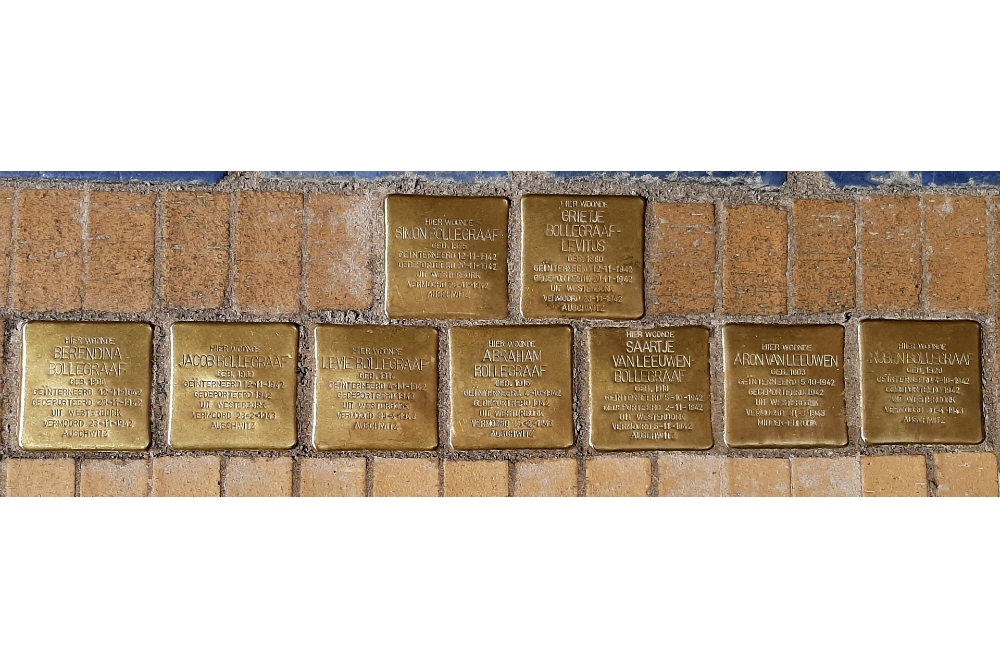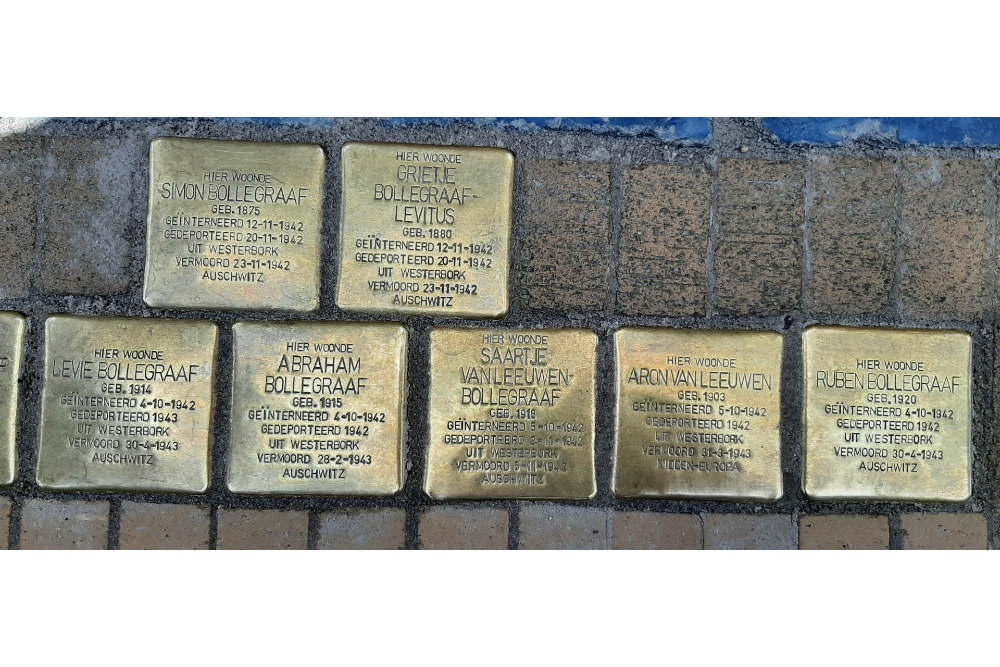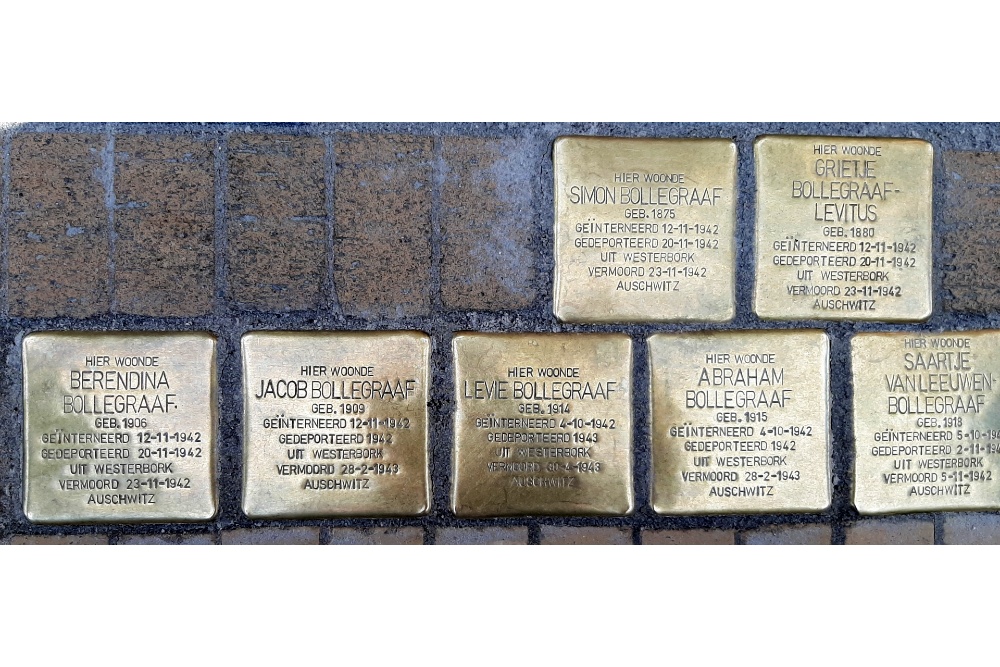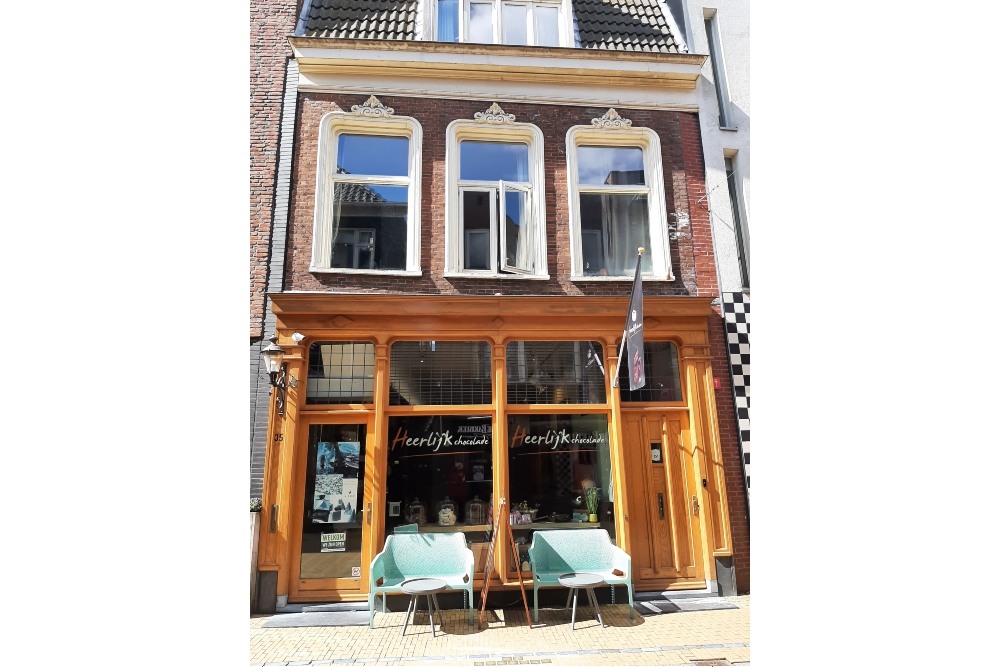Stumbling Stones Folkingestraat 35
These small brass plaques (Stolpersteine or Stumbling Stones) were laid on 18 April 2024 and commemorate:
Simon Bollegraaf, born 13 September 1875 in Slochteren, murdered in Auschwitz on 23 November 1942.
Grietje Bollegraaf-Levitus, born 18 April 1880 in Onstwedde, murdered in Auschwitz on 23 November 1942.
Berendina Bollegraaf, born 24 February 1906 in Groningen, murdered in Auschwitz on 23 November 1942.
Jacob Bollegraaf, born 6 December 1909 in Groningen, murdered in Auschwitz on 28 February 1943.
Levie Bollegraaf, born 27 March 1914 in Groningen, murdered in Auschwitz on 30 April 1943.
Abraham Bollegraaf, born 17 May 1915 in Groningen, murdered in Auschwitz on 28 February 1943.
Saartje van Leeuwen-Bollegraaf, born 16 April 1918 in Groningen, murdered 5 November 1942 in Auschwitz.
Aron van Leeuwen, born 21 February 1903 in The Hague, murdered around 31 March 1943 in Central Europe.
Ruben Bollegraaf, born 20 February 1887 in Groningen, murdered 12 October 1942 in Auschwitz.
Musician's family:
Music is significant, as the three brothers Ruben, Levie and Jacob formed a musical society with three other non-Jewish musicians before World War II: the Bolly Band. They performed in various places, from Groningen to Sappemeer to Borger. The band played at theatre performances, exhibitions and sporting events. A few years later, instead of playing music at parties, they would join the camp orchestra at Auschwitz extermination camp. The brothers did not survive the concentration camp, as did their sisters and parents who were also murdered there.
In total, five of the seven Bollegraaf children earned their living as musicians. The musical family lived at 35 Folkingestraat, where father Simon Bollegraaf had a clothes shop. At number 10, daughter Claartje van der Wijk-Bollegraaf lived with her husband Izak and children Jozef and Grietje.
With the developments in Nazi Germany in 1939, the family put all their instruments up for sale in the newspaper. It looked like they wanted to leave, but despite the fear they decided to stay. The instruments were not sold and they continued, even during the war, to make music. But in 1942, the curtain fell: the clothing shop was closed by the Germans and the family was banned from music. That same year, they were deported to Auschwitz.
"Stolpersteine" is an art project in Europe by Gunter Demnig to commemorate victims of National Socialism (Nazism).
Stolpersteine (trip stones) are small, 10x10cm brass plaques placed in the pavement in front of a residence of (mostly Jewish) victims murdered by the Nazis. Each plaque is engraved with the victim's name, date of birth and place (usually a concentration camp) and date of death. In this way, Gunter Demnig gives an individual memorial to each victim. One stone, one name, one person. He quotes the Talmud: "A person is forgotten only when his or her name is forgotten."
Do you have more information about this location? Inform us!
Source
- Text: Bert Deelman
- Photos: Bert Deelman
- https://www.joodsmonument.nl/nl/page/52552/folkingestraat-35-groningen
Nearby
Point of interest
- Bullet Impacts Gedempte Zuiderdiep 133 - Groningen
- Tile Tableau Korenbeurs - Groningen
- Hiding Place Der Aa Church - Groningen
Monument
- Stumbling Threshold Folkingestraat 34 - Groningen
- Memorial "ALSO HERE" - Groningen
- Memorial to the Jewish Inhabitants of Groninger Slums - Groningen
Cemetery
- Dutch War Graves Zuiderbegraafplaats - Groningen
- Commonwealth War Graves Groningen - Groningen
- Dutch War Graves RC Churchyard - Groningen
Remembrance Stone
- Stumbling Stone Folkingestraat 41 - Groningen
- Stumbling Stone Folkingestraat 17 - Groningen
- Stumbling Stones Folkingestraat 18a - Groningen
Fortification
- German Shelter Suikerunie Factory - Groningen
- German Tobruk Bunker Suikerunie Factory - Groningen
- German Bunker Haren - Haren







